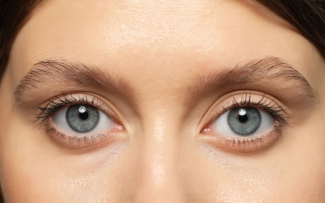Grey Eyes
Often admired for their light appearance, grey eyes stand out for their complexity and distinctiveness. They differ from other light-coloured eyes not just in hue, but in structure, melanin concentration, and how light interacts with the iris.
The subtle interplay of light gives them a unique depth, often shifting slightly in tone depending on the environment. These characteristics make grey eye colour both rare and fascinating to explore.
Read on to learn about the rarity, science, variations, and notable people with grey-coloured eyes. Also, discover how coloured contact lenses can enhance or reproduce this unique look.
How rare is the grey eye colour?
Grey-coloured eyes vary in shade and depth, ranging from dark grey to shades with hints of green or blue. They are exceptionally rare, found in less than 3% of the global population.
This unusual trait is most prevalent among people of European descent, particularly from Northern European countries such as Finland, Iceland, and Sweden.
What causes grey eyes?
The colour of your eyes depends on the amount and distribution of melanin (pigment) in the iris. Grey eye colour occurs when the iris has very little melanin, and most of that melanin is concentrated in the back layer of the iris. This lack of melanin causes light to scatter in a way that gives the eyes a cloudy, greyish appearance.
You have melanin throughout your body, not just in your eyes. It affects the color of your hair and skin as well. The more melanin you have, the more likely you are to have dark complexion, dark eyes, and other dark features.
Genetic factors behind grey eyes
Grey eyes are not dictated by a single dominant-recessive gene model. Instead, multiple genes likely influence their development, with genetic variations affecting melanin production and distribution. Ongoing research continues to explore the complexity of these genetic factors.
Shades of grey eyes
Grey eyes are usually not a single shade, but a subtle mix of multiple colours. Most variations can be classified into one of the following shades:
- Blue-grey – A mix of blue undertones with a grey base
- Green-grey – A soft, earthy blend of green and grey tones
- Steel grey – A deeper, more intense shade similar to charcoal
Grey-coloured eyes can appear to shift slightly depending on the surrounding lighting, clothes, and accessories. This adaptability makes the grey eye colour uniquely versatile, often reflecting the moods and tones of the environment.
Grey vs. blue eyes
Though the colours can appear very similar in certain lighting, there are a few distinctions between grey and blue eyes.
Grey eyes have higher levels of collagen in the front layer of the iris, the layer that scatters light as it enters the eye. This added collagen produces a softening effect as light scatters, giving grey-coloured eyes their muted, misty look.
In contrast, blue eyes have less collagen in the front layer of the iris. This causes light to scatter more directly when entering the eye, which can make blue eyes appear more vibrant.
Other facts about grey eyes
Beyond their striking appearance, grey-coloured eyes come with unique traits and considerations, including light sensitivity and potential health risks.
Light sensitivity and UV exposure
Like other light-coloured eyes, grey eyes tend to be more sensitive to bright light and UV damage. With reduced melanin levels, it’s harder for the eyes to block harmful UV rays naturally.
The best way to protect your eyes from the sun is to wear sunglasses with 100% UVA-UVB lens protection (UV 400). Dark-tinted lenses can also help address issues with light sensitivity.
Wearing UV-blocking contact lenses can provide an extra layer of sun protection for your eyes, but they don’t provide as much coverage or block as much UV radiation as UV 400 sunglasses.
Increased risk of eye conditions
Because of their lower melanin levels, people with grey eyes may have a higher risk of developing certain eye conditions. They could be more susceptible to cataracts, certain types of eye cancer, and macular degeneration. It is crucial for people with grey or light-coloured eyes to reduce their risks and protect their eyes from excessive sunlight.
Celebrities with grey eyes
People with grey or blue-grey eyes tend to stand out due to their distinct eye colour. Famous people with grey eyes (or, at minimum, greyish-looking eyes) include:
- Daniel Craig
- Kate Winslet
- Michael Fassbender
- Jude Law
- Adele
- Saoirse Ronan
- Sophie Turner
Show off your grey eyes
Grey-coloured eyes are a rare and captivating trait that stand out on their own. But subtle shifts in lighting can reveal different undertones — like blue, green, or silver — to give them a more dynamic appearance. The right styling choices can enhance your eyes’ natural beauty so they’ll shine in any setting.
Experiment with different clothing colours and makeup techniques until you find the best ways to accentuate your grey-coloured eyes. Both neutral palettes and bold accents have potential to bring out unique features, giving you the flexibility to adjust your look based on the mood or occasion.
Enhance the uniqueness of your grey eyes with coloured contacts (or try out the colour if your eyes aren’t grey already). Explore different shades and learn how subtle changes can make your grey eyes pop even more.
If you don’t have a current contact lens prescription, book an eye test with our trusted partners at Vision Express to discover if coloured contacts are right for you.
SOURCES:
- Gray eyes: A rare and beautiful eye color. All About Vision. January 2021.
- Are grey eyes rare? Discover more about this unique eye colour. Glasses Direct. April 2024.
- Is eye color determined by genetics? MedlinePlus. National Library of Medicine. July 2022.
- How eye color develops and why it changes. All About Vision. March 2019.
- Why are grey eyes so rare? Vision Center. September 2024.
- What are the rarest eye colors? Verywell Health. August 2024.


